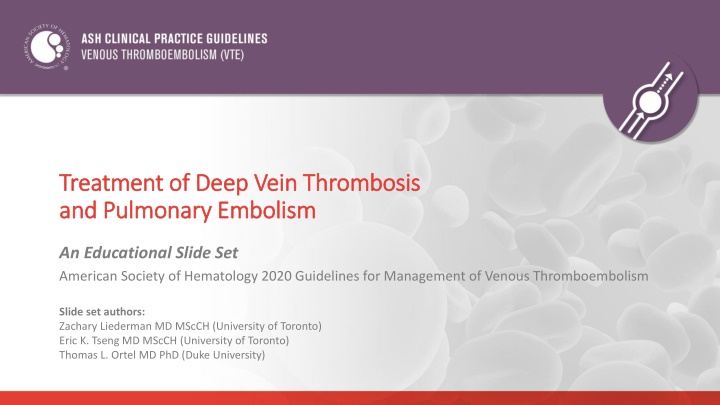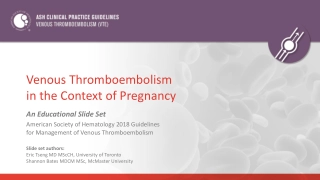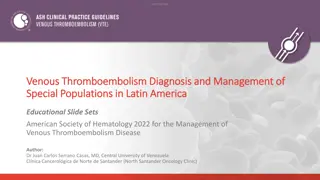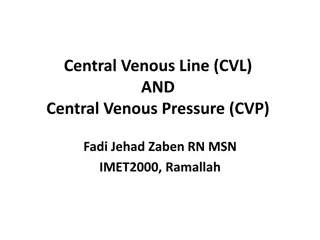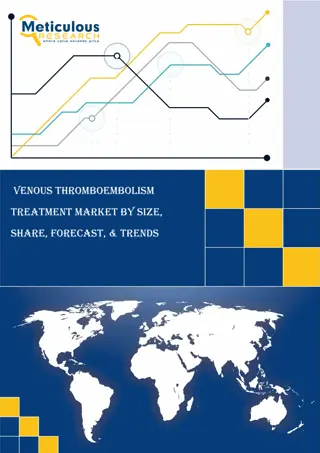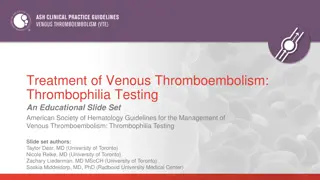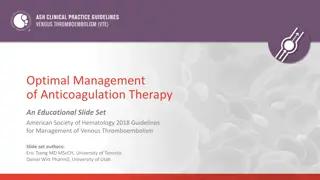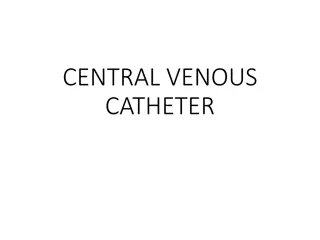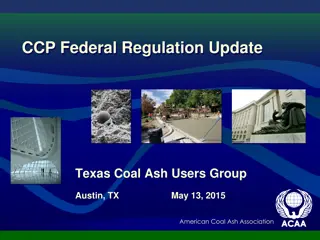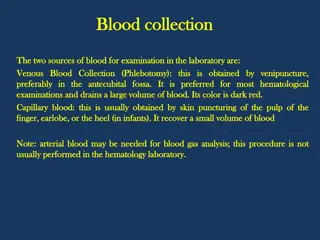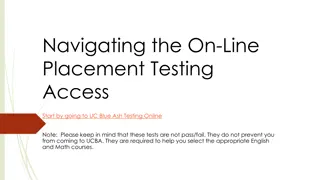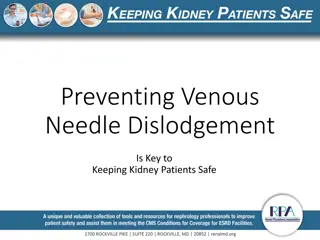ASH Guidelines 2020: Management of Venous Thromboembolism
American Society of Hematology (ASH) released guidelines in 2020 for the management of Venous Thromboembolism, focusing on deep vein thrombosis and pulmonary embolism. These guidelines cover prevention, treatment, and optimal management strategies. The recommendations are developed through a rigorous process involving clinical questions, evidence synthesis, and panel formation, providing strong and conditional recommendations for patients and clinicians to utilize based on individual preferences.
Uploaded on Jul 10, 2024 | 1 Views
Download Presentation

Please find below an Image/Link to download the presentation.
The content on the website is provided AS IS for your information and personal use only. It may not be sold, licensed, or shared on other websites without obtaining consent from the author.If you encounter any issues during the download, it is possible that the publisher has removed the file from their server.
You are allowed to download the files provided on this website for personal or commercial use, subject to the condition that they are used lawfully. All files are the property of their respective owners.
The content on the website is provided AS IS for your information and personal use only. It may not be sold, licensed, or shared on other websites without obtaining consent from the author.
E N D
Presentation Transcript
Treatment of Deep Vein Thrombosis Treatment of Deep Vein Thrombosis and Pulmonary Embolism and Pulmonary Embolism An Educational Slide Set American Society of Hematology 2020 Guidelines for Management of Venous Thromboembolism Slide set authors: Zachary Liederman MD MScCH (University of Toronto) Eric K. Tseng MD MScCH (University of Toronto) Thomas L. Ortel MD PhD (Duke University)
Clinical Guidelines American Society of Hematology 2020 guidelines for management of venous thromboembolism: treatment of deep vein thrombosis and pulmonary embolism Thomas L. Ortel, Ignaci Barbarao Neumann, Walter Ageno, Rebecca Beyth, Nathan P. Clark, Adam Cuker, A. Hutten, Michael R. Jaff, Veena Manja, Sam Schulman, Caitlin Thurston, Suresh Vedantham, Peter Verhamme, Daniel M. Witt, Ivan D. Florez, Ariel Izcovich, Robby Nieuwlaat, Stephanie Ross, Holger J. Sch nemann, Wojtek Wiercioch, Yuan Zhang, Yuqing Zhang
ASH Clinical Practice Guidelines on VTE 1. Prevention of VTE in Surgical Hospitalized Patients 2. Prevention of VTE in Medical Hospitalized Patients 3. Treatment of Acute VTE (DVT and PE) 4. Optimal Management of Anticoagulation Therapy 5. Prevention and Treatment of VTE in Patients with Cancer 6. Heparin-Induced Thrombocytopenia (HIT) 7. Thrombophilia 8. Pediatric VTE 9. VTE in the Context of Pregnancy 10. Diagnosis of VTE 11. Anticoagulation in Patients with COVID-19 12. Adaptation of ASH Management of VTE Guidelines for Latin America
How were these ASH guidelines developed? CLINICAL QUESTIONS 20 to 30 clinically-relevant questions generated in PICO format (population, intervention, comparison, outcome) EVIDENCE SYNTHESIS Evidence summaries incorporated into Evidence to Decision (EtD) frameworks, which also addressed: MAKING RECOMMENDATIONS Recommendations made by guideline panel members based on EtD frameworks. PANEL FORMATION Each guideline panel was formed following these key criteria: Balance of expertise (including disciplines beyond hematology, and patients) Close attention to minimization and management of conflicts of interest Resource use Feasibility Acceptability Equity Patient values and preferences Example: PICO question Should thrombolytic therapy in addition to anticoagulation vs. anticoagulation alone be used for patients with extensive proximal DVT?
How patients and clinicians should use these recommendations STRONG Recommendation ( The panel recommends ) CONDITIONAL Recommendation ( The panel suggests ) Most individuals would want the intervention. A majority would want the intervention, but many would not. For patients Different choices will be appropriate for different patients, depending on their values and preferences. Use shared decision making. Most individuals should receive the intervention. For clinicians
Grading the quality of evidence Low (or Very Low) Moderate Strong
Objectives By the end of this session, you should be able to 1. Describe the initial management of patients with deep vein thrombosis (DVT) and pulmonary embolism (PE) 2. Describe recommendations for duration of anticoagulation after venous thromboembolism (VTE) 3. Describe recommendations for management of recurrent VTE
VTE is a common and important cause of morbidity and mortality One third of patients with newly diagnosed VTE present with PE VTE (including DVT and PE) occurs in 1-2 per 1,000 people per year For patients with unprovoked VTE, risk of recurrence after completing a primary treatment course of anticoagulation is about 10% in two years The incidence of VTE increases with age as high as 1 in 100 in individuals above 80 years old
These guidelines These guidelines are about managing VTE during: Initial stages (within 2 weeks) Primary treatment (3-6 months) Secondary prevention (beyond 6 months)
Case 1: Unprovoked DVT 48 year old male Medical History: None Medications: None Seen in the Emergency Department with: left leg pain and swelling x 24 hours Heart rate 80 beats per min Respiratory rate 16 breaths per min Oxygen saturation 99% on room air Blood pressure 130/80 (+) Left calf swelling D-dimer: 2,500 mcg/ml Leg US: distal external iliac vein, superficial femoral and popliteal vein non-compressible (occlusive DVT)
What initial management plan would you recommend: A. Anticoagulation only B. Thrombolysis in addition to anticoagulation C. Compression stockings in addition to anticoagulation D. IVC filter insertion in addition to anticoagulation
Recommendation In most patients with proximal DVT, the panel suggests anticoagulation therapy alone over thrombolytic therapy in addition to anticoagulation (conditional recommendation, low certainty) Thrombolytic therapy + Anticoagulation compared with Anticoagulation alone in patients with extensive proximal DVT: Anticipated absolute effects (95% CI) Remarks: Patients with limb threatening DVT may require thrombolysis Relative effect: RR (95% CI) Outcomes Risk with Anticoagulation Risk difference with thrombolytic therapy + anticoagulation 0.77 2 fewer deaths per 1,000 (7 fewer to 12 more) Mortality 9 per 1,000 (0.26-2.28) 0.71 186 fewer PTS per 1,000 (96 fewer to 253 more) PTS 641 per 1,000 (0.60 to 0.085) 1.85 31 more bleeds per 1,000 (15 fewer to 52 more) Major bleeding 36 per 1,000 (1.41 to 2.44) Quality of Evidence (GRADE): Low Moderate Strong
Recommendation For patients with DVT including those at increased risk of PTS, the panel suggests against the use of compression stockings (conditional recommendation, low certainty) Anticoagulation alone compared with compression stockings and anticoagulation in patients with extensive DVT: Anticipated absolute effects (95% CI) Remarks: Stockings may still be considered for symptomatic relief in select patients Relative effect: RR (95% CI) Outcomes Risk with VKA Risk difference with DOAC 0.99 0 fewer deaths per 1,000 (13 fewer to 17 more) Mortality 46 per 1,000 (0.72-1.36) 0.72 4 fewer PE per 1,000 (10 fewer to 10 more) PE 15 per 1,000 (0.31-1.70) 0.56 18 fewer DVT per 1,000 (35 fewer to 68 more) DVT 40 per 1,000 (0.12 to 2.70) 0.62 81 fewer cases of PTS per 1,000 (132 fewer to 2 more) PTS 213 per 1,000 (0.38 to 1.01) Quality of Evidence (GRADE): Low Moderate Strong
Treatment beyond anticoagulation for prevention of Post Thrombotic Syndrome (PTS) PTS may develop in 30% to 50% patients (5% to 10% severe) Adjunctive therapies can include compression stockings and thrombolysis: o Trend towards decreased PTS but not significant o No impact on mortality o For thrombolysis increased bleeding risk There remains low certainty in the evidence and therapy may be considered for patients with: o Low risk of bleeding (thrombolysis) o Value rapid resolution of symptoms and prevention of PTS
Recommendation In patients with VTE, the panel suggests using DOACs over VKAs (conditional recommendation, moderate certainty) DOAC compared with VKA for VTE: Anticipated absolute effects (95% CI) Remarks: May not be appropriate for all patient populations Relative effect: RR (95% CI) Outcomes Risk with VKA Risk difference with DOAC 0.99 0 fewer deaths per 1,000 (6 fewer to 6 more) Mortality 39 per 1,000 (0.85-1.15) 0.97 1 fewer PE per 1,000 (5 fewer to 5 more) The panel does not suggest one DOAC over another PE 20 per 1,000 (0.77-1.23) 0.80 5 fewer DVT per 1,000 (2 more to 11 fewer) DVT 26 per 1,000 (0.59 to 1.09) 0.63 6 fewer bleeds per 1,000 (3 fewer to 9 fewer) Major bleeding 17 per 1,000 (0.47 to 0.84) Quality of Evidence (GRADE): Low Moderate Strong
Recommendation For patients with uncomplicated DVT, the ASH guideline panel suggests offering home treatment over hospital treatment (conditional recommendation, low certainty) Home treatment compared with hospital treatment in patients continuing on indefinite anticoagulation Anticipated absolute effects (95% CI) Remarks: Hospital treatment may benefit patients with limb threatening DVT or those at high risk of bleeding Relative effect: RR (95% CI) Outcomes Risk with hospital treatment Risk difference with home treatment Mortality (10 days) Not estimable 4 per 1,000 Not estimable 0.64 25 fewer PE per 1,000 (38 fewer to 5 fewer) PE 68 per 1,000 (0.44 to 0.93) 0.61 29 fewer DVT per 1,000 (43 fewer to 7 fewer) DVT 74 per 1000 (0.42 to 0.90) 0.67 6 fewer bleeds per 1,000 (13 fewer to 7 more) Major bleeding 19 per 1,000 (0.33 to 1.36) Quality of Evidence (GRADE): Low Moderate Strong
Case: back to our patient Uncomplicated unprovoked VTE in previously well patient Initial management: o Anticoagulation only (no thrombolysis, no compression stockings, no IVC filter) o DOAC over VKA o Home treatment over hospital treatment
The patient receives 6 months of anticoagulation for primary treatment. What duration of anticoagulation do you recommend for secondary prevention? A. 6-12 months B. No secondary prevention is required C. Indefinite D. Will depend on use of prognostic scores
Recommendation After primary treatment for patients with unprovoked DVT or PE, the panel suggests indefinite antithrombotic therapy (conditional, moderate certainty) Indefinite anticoagulation compared with stopping anticoagulation in patients with unprovoked VTE after primary treatment: Anticipated absolute effects (95% CI) Remarks: Does not apply to patients who are at high risk of bleeding complication Relative effect: RR (95% CI) Outcomes Risk with stopping Risk difference with indefinite anticoagulation 0.75 5 fewer deaths per 1,000 (9 fewer to 2 more) Mortality 18 per 1,000 (0.49-1.13) 0.29 21 fewer PE per 1,000 (25 fewer to 13 more) PE 29 per 1,000 (0.15 to 0.056) 0.20 50 fewer DVT per 1,000 (56 fewer to 42 fewer) DVT 63 per 1000 (0.12 to 0.34) 2.17 6 more bleeds per 1,000 (2 more to 12 more) Major bleeding 5 per 1,000 (1.40 to 3.35) Quality of Evidence (GRADE): Low Moderate Strong
Recommendation For patients with unprovoked DVT and/or PE, the panel suggests against routine use of prognostic scores, D-Dimer testing or ultrasound to guide the duration of anticoagulation (conditional, low certainty) D-Dimer Testing U/S Prognostic Scores Residual vein thrombus HERDOO2 VIENNA DASH Persistently elevated D-Dimer Anticipated absolute effects (95% CI) Relative effect: RR (95% CI) Outcomes Risk difference with prognostic tools Standard risk N/A: Insufficient evidence for treatment outcomes based on prognostic tools compared to standard approach
Recommendation For patients with DVT and/or PE who will continue with a DOAC for secondary prevention, the panel suggests using standard-dose DOAC or lower-dose DOAC (conditional recommendation, moderate certainty) Lower-dose compared with standard-dose DOAC in patients continuing on indefinite anticoagulation Anticipated absolute effects (95% CI) Lower dose DOAC regimens for secondary prevention of VTE Apixaban 2.5 mg BID Rivaroxaban 10 mg OD Relative effect: RR (95% CI) Outcomes Risk with standard dose Risk difference with reduced dose DOAC 0.68 5 fewer deaths per 1,000 (9 fewer to 2 more) Mortality 6 per 1,000 (0.10-4.57) 1.25 21 fewer PE per 1,000 (25 fewer to 13 more) PE 5 per 1,000 (0.54 to 2.91 0.75 50 fewer DVT per 1,000 (56 fewer to 42 fewer) DVT 9 per 1000 (0.36 to 1.53) 0.97 6 more bleeds per 1,000 (2 more to 12 more) Major bleeding 4 per 1,000 (0.34 to 2.80) Quality of Evidence (GRADE): Low Moderate Strong
Case Conclusion Uncomplicated unprovoked VTE in previously well patient Initial management: o Anticoagulation only (no thrombolysis, no compression stockings, no IVC filter) o DOAC over warfarin o Home treatment over hospital treatment Duration: o Indefinite antithrombotic therapy o Standard or reduced dose DOAC Diagnosis of DVT/PE Initial Management Primary Treatment Secondary Prevention Planned indefinite duration 3 to 6 months First 5-21 days after diagnosis
Case 2: Provoked DVT and PE (transient risk factor) 76 year old male Medical History: CAD (MI 5 years earlier), HTN, Type 2 Diabetes Medications: ASA, Amlodipine, Metformin, Rosuvastatin Seen in the Emergency Department with: SOB and right leg pain x 48 hours. Underwent total hip replacement 1 week earlier and has not been taking prescribed DVT prophylaxis. Heart rate 90 beats per min Respiratory rate 22 breaths per min Oxygen saturation 99% on RA Blood pressure 150/90 (+) Right calf swelling Right Leg US: superficial femoral and popliteal vein non-compressible (occlusive DVT) CTPA: Pulmonary embolism involving segmental arteries of the left lower lobe
Recommendations IVC filter insertion is not routinely recommended unless there is a contraindication to anticoagulation For patients with proximal DVT and significant pre-existing cardiopulmonary disease, as well as for patients with PE and hemodynamic compromise, the panel suggests anticoagulation alone rather than anticoagulation plus insertion of an IVC filter (conditional recommendation, low certainty) IVC filter in addition to anticoagulation versus anticoagulation alone (NO FILTER): Outcomes Relative effect (95% CI) Anticipated absolute effects (95% CI) If IVC filter is inserted (e.g., high bleeding risk) a retrievable filter is recommended with removal once patient can safely receive anticoagulant therapy (Quality of Evidence) Risk with NO FILTER Risk difference using FILTER RR 1.15 (0.83 to 1.60) 9 more death per 1,000 (10 fewer to 36 more) Mortality 60 per 1000 RR 0.54 (0.22 to 1.33) 2 fewer PE per 1,000 (4 fewer to 2 more) PE 5 per 1000 RR 1.64 (0.93 to 2.90) 3 more DVT per 1,000 (0 fewer to 10 more) DVT 5 per 1,000 Quality of Evidence (GRADE): Low Moderate Strong
Recommendation For patients with DVT and/or PE with stable CVD, previously taking aspirin the panel suggests suspending aspirin for the duration of anticoagulation therapy (conditional, very low certainty) Suspending ASA (Anticoagulation alone) compared with Continuing ASA (ASA + anticoagulation) Anticipated absolute effects (95% CI) Remarks: Does not apply to patients with recent coronary event or coronary intervention Relative effect: RR (95% CI) Outcomes Risk with stopping ASA Risk with continuing ASA (ASA + Anticoagulation) 1.26 7 more bleeds per 1,000 (2 fewer to 21 more) Major bleeding 29 per 1,000 (0.34 to 2.80) Quality of Evidence (GRADE): Low Moderate Strong
Recommendation In patients with pulmonary embolism (PE) with low risk of complications, the panel suggests home treatment over hospital treatment (conditional recommendation, very low certainty) Home treatment compared with hospital treatment in patients continuing on indefinite anticoagulation Remarks: Hospital treatment may benefit patients with submassive or massive PE, a high risk for bleeding or requiring IV analgesics Anticipated absolute effects (95% CI) Relative effect: RR (95% CI) Outcomes Risk with hospital treatment Risk difference with home treatment 0.33 3 fewer deaths per 1,000 (4 fewer to 30 more) Mortality (30 days) 4 per 1,000 (0.01 to 7.98) 2.95 0 fewer PE per 1,000 (0 fewer to 0 fewer) PE 0 per 1,000 (0.12 to 71.85) Not estimable DVT 0 per 1000 Not estimable 6.88 0 fewer bleeds per 1,000 (0 fewer to 0 fewer e) Major bleeding 0 per 1,000 (0.36 to 132.14) Quality of Evidence (GRADE): Low Moderate Strong
Case: back to our patient Provoked DVT and PE (transient risk factor) in patient with cardiopulmonary disease Initial management: o Anticoagulation only (no thrombolysis, no compression stockings, no IVC filter) o DOAC over warfarin o Suspend ASA o Home treatment over hospital treatment The patient is shocked that this happened to him and asks what caused his blood clot.
Provoking Risk Factors for VTE Transient Risk Factors (resolve after provoked VTE) Chronic (Persistent) Risk Factors (persistent after VTE occurs) MAJOR Risk Factor (occurs within 3 mth) Surgery, gen anesthesia > 30 min Confined to hospital bed 3 days with acute illness Cesarean section Active cancer (ongoing chemo; recurrent or progressive disease) Inflammatory bowel disease Autoimmune disorder (e.g., antiphospholipid syndrome, rheumatoid arthritis) Chronic infection Chronic immobility (e.g., spinal cord injury) MINOR Risk Factor (occurs within 2 mth) Estrogen therapy (OCP, HRT) Pregnancy, puerperium Confined to bed out of hospital 3 days with acute illness Leg injury, reduced mobilty 3 days
The patient recovers well in hospital and is ready for discharge. In the absence of any major bleeding concerns, for how long should this patient be treated with anticoagulation? A. 3-6 months B. 6-12 months C. Indefinite D. 6 weeks
Recommendation For primary treatment of deep venous thrombosis or pulmonary embolism, the panel suggests short term (3-6 months) over long term anticoagulation (6-12 months) (conditional recommendation, moderate certainty) Long-term compared with short-term anticoagulation for patients with VTE provoked by transient risk factor Anticipated absolute effects (95% CI) Remarks: For VTE provoked by transient risk factor, secondary prevention does not need to be considered Relative effect: RR (95% CI) Outcomes Risk with short- term Risk difference with long-term anticoagulation 1.38 7 more deaths per 1,000 (3 fewer to 22 more) Mortality 18 per 1,000 (0.85 to 2.23) 0.66 17 fewer PE per 1,000 (35 fewer to 25 more) PE 50 per 1,000 (0.29 to 1.151 0.50 50 fewer DVT per 1,000 (24 fewer to 10 fewer) DVT 117 per 1000 (0.27 to 0.95)) 1.46 6 more bleeds per 1,000 (3 fewer to 22 more) Major bleeding 13 per 1,000 (0.78 to 2.73) *Results based on approx. 2.5 year follow up Quality of Evidence (GRADE): Low Moderate Strong
Case: back to our patient Provoked (transient risk factor) PE in patient with cardiopulmonary disease Initial management: o Anticoagulation only (no thrombolysis, no compression stockings, no IVC filter) o DOAC over warfarin o Suspend ASA o Home treatment over hospital treatment Diagnosis of DVT/PE Initial Management Primary Treatment Secondary Prevention Duration: o 3-6 months o No secondary prevention Not indicated 3 to 6 months First 5-21 days after diagnosis Can resume ASA if otherwise indicated
Case epilogue: Three years later while on ASA only, the patient undergoes an appendectomy for appendicitis. Seven days after surgery, the patient has new leg swelling and is diagnosed with an acute left leg DVT. ASA is suspended and he is restarted on a DOAC for 3 months. For how long should he be treated with anticoagulation? A. 3-6 months B. 6-12 months C. Indefinite D. 6 weeks
Recommendation For patients who develop a DVT and/or PE provoked by a transient risk factor and have a history of a previous provoked thrombotic event the panel suggests stopping anticoagulation after completion of primary treatment (conditional recommendation, moderate certainty) Long-term compared with short-term anticoagulation for patients with recurrent provoked VTE Anticipated absolute effects (95% CI) Relative effect: RR (95% CI) Outcomes Risk with short- term Risk difference with long-term anticoagulation 0.75 7 more deaths per 1,000 (3 fewer to 22 more) Mortality 18 per 1,000 (0.49 to 1.13) 0.29 17 fewer PE per 1,000 (35 fewer to 25 more) PE 29 per 1,000 (0.15 to 0.56) 0.20 50 fewer DVT per 1,000 (24 fewer to 10 fewer) DVT 117 per 1000 (0.12 to 0.34) 2.17 6 more bleeds per 1,000 (3 fewer to 22 more) Major bleeding 5 per 1,000 (1.40 to 3.35) Quality of Evidence (GRADE): Low Moderate Strong
Case Conclusion Provoked PE (transient risk factor) in patient with pre-existing cardiopulmonary disease Initial management: oAnticoagulation only (no thrombolysis, no compression stockings, no IVC filter) o DOAC over warfarin o Suspend ASA o Home treatment over hospital treatment Duration: o3-6 months o No secondary prevention (can resume ASA if otherwise indicated) Recurrent VTE: o Reassess for initial management and primary treatment duration o No secondary prevention (in cases where first event is unprovoked, indefinite antithrombotic therapy is recommended
Case 3: Provoked submassive PE (chronic risk factor) 56 year old female Medical History: Inflammatory Bowel Disease, CKD (CrCl 14 ml/min) Medications: Infliximab Seen in the Emergency Department with: Presyncope after 2 days of SOB and chest pain. Heart rate 104 beats per min Respiratory rate 22 breaths per min Oxygen saturation 98% on 2L Blood pressure 150/90 Troponin: Troponin-T HS 250 ng/L CTPA: Pulmonary embolism involving bilateral segmental arteries Bedside echo: no clear evidence of right heart strain
.This patient has extensive bilateral PE with positive troponin and radiographic findings of right heart strain She is tachycardic but hemodynamically stable and responding well to IV fluids. What initial management plan would you recommend: A. Anticoagulation only B. Systemic thrombolysis in addition to anticoagulation C. Catheter-directed thrombolysis in addition to anticoagulation D. IVC filter insertion in addition to anticoagulation
Recommendation. For patients with PE with echocardiography and/or biomarkers compatible with right ventricular dysfunction but without hemodynamic compromise (submassive PE), the panel suggests anticoagulation alone over the routine use of thrombolysis in addition to anticoagulation (conditional recommendation, low certainty) Thrombolytic therapy in addition to anticoagulation versus anticoagulation alone: Remarks: Thrombolysis is reasonable to consider for younger patients with submassive PE at low risk for bleeding Patients with submassive PE should be monitored closely for hemodynamic compromise Anticipated absolute effects (95% CI) Outcomes (Quality of Evidence) Relative effect (95% CI) Risk with Risk difference using THROMBOLYSIS IN ADDITION TO ANTICOAG. ANTICOAGULATION ALONE RR 0.61 (0.40 to 0.94) 58 fewer death per 1,000 (9 fewer to 90 fewer) Mortality 133 out of 1,000 (13.3%) RR 0.56 (0.35 to 0.91) 7 fewer PE per 1,000 (10 fewer to 2 fewer) PE 16 out of 1,000 (1.6%) Major bleeding RR 1.89 (1.46 to 2.46) 31 more bleed per 1,000 (16 more to 51 more) 28 out of 1,000 (2.8%) Hemodynamic compromise: sBP < 90 mm Hg, or a decrease in sBP 40 mm Hg from baseline Intracranial hemorrhage RR 3.17 (1.19-8.41) 7 more ICH per 1,000 (1 more to 21 more) 3 per 1,000 (0.3%) Quality of Evidence (GRADE): Low Moderate Strong
Patient is started on IV UFH and bridged to warfarin (preferred due to CKD), what do you recommend for duration and type of antithrombotic therapy? A. 3-6 months of anticoagulation then stop B. 3-6 months of anticoagulation, then continue anticoagulant therapy for secondary VTE prevention indefinitely C. 3-6 months of anticoagulation then switch to ASA for secondary VTE prevention D. 6-12 months of of anticoagulation then stop
Recommendation After primary treatment for patients with DVT and/or PE provoked by a chronic risk factor, the panel suggests indefinite antithrombotic therapy over stopping anticoagulation (conditional recommendation moderate certainty) Long-term compared with short-term anticoagulation for patients with VTE provoked by chronic risk factor Anticipated absolute effects (95% CI) Chronic thrombotic risk factors include: Inflammatory bowel disease Autoimmune disease Active cancer Chronic immobility Chronic infections Relative effect: RR (95% CI) Outcomes Risk with short- term Risk difference with long-term anticoagulation 0.75 4 fewer deaths per 1,000 (8 fewer to 2 more) Mortality 16 per 1,000 (0.49 to 1.13) 0.29 21 fewer PE per 1,000 (25 fewer to 13 fewer) PE 29 per 1,000 (0.15 to 0.56) 0.20 50 fewer DVT per 1,000 (56 fewer to 42 fewer) DVT 63 per 1000 (0.12 to 0.34) 2.17 6 more bleeds per 1,000 (2 more to 12 more) Major bleeding 5 per 1,000 (1.40 to 3.35) Quality of Evidence (GRADE): Low Moderate Strong *Results based on approx. 2 year follow up
Recommendation For patients with DVT and/or PE who will continue to receive secondary prevention, the panel suggests using anticoagulation over aspirin (conditional recommendation, moderate certainty) Aspirin compared with anticoagulation for patients with receiving secondary prevention for prior VTE Anticipated absolute effects (95% CI) Relative effect: RR (95% CI) Outcomes Risk with anticoagulation Risk difference with aspirin 0.86 1 fewer deaths per 1,000 (5 fewer to 10 more) Mortality 7 per 1,000 (0.31 to 2.35) 3.10 11 more PE per 1,000 (1 more to 36 more) PE 5 per 1,000 (1.24 to 7.73) 3.15 17 more DVT per 1,000 (4 more to 46 more) DVT 8 per 1000 (1.50 to 6.63) 0.49 3 fewer bleeds per 1,000 (5 fewer to 5 more) Major bleeding 5 per 1,000 (0.12 to 1.95) Quality of Evidence (GRADE): Low Moderate Strong
Case Conclusion Provoked submassive PE (chronic risk factor) Initial management: oAnticoagulation only (no thrombolysis, no compression stockings, no IVC filter) o Consider admission to hospital Duration of anticoagulation o Indefinite antithrombotic therapy with anticoagulation rather than ASA
Other guideline recommendations that were not covered in this session Home treatment vs hospital treatment for patients with PE and low risk for complication Thrombolytic therapy plus anticoagulation vs anticoagulation alone for patients with PE and hemodynamic compromise Systemic vs. catheter-directed thrombolysis for DVT, PE Breakthrough VTE INR intensity on warfarin when being used as the anticoagulant for secondary prophylaxis
Future Priorities for Research Which patients with DVT or PE would benefit most from thrombolytic therapy and optimal strategy for administration Which patient populations would benefit most from the incorporation of 1 of prognostic scores, D- dimer testing, and/or ultrasound into the decision-making process concerning whether anticoagulant therapy should be continued after completion of the primary treatment phase of therapy. Impact of different chronic risk factors on the rate of recurrent VTE Which patients can safely use a lower-dose DOAC for secondary prevention The evaluation and management of patients who sustain breakthrough thromboembolic events Which patients should continue antiplatelet therapy when anticoagulant therapy is initiated and which anticoagulant agent(s) and dose(s) are safest when coadministered with antiplatelet therapy. Which patients would potentially benefit from the use of compression stockings.
In Summary: Back to our Objectives 1. Describe the initial management of patients with deep vein thrombosis (DVT) and pulmonary embolism (PE) 2. Describe recommendations for duration of anticoagulation after venous thromboembolism (VTE) 3. Describe recommendations for management of recurrent VTE
Acknowledgements ASH Guideline Panel team members Knowledge Synthesis team members McMaster University GRADE Centre Authors of this slide set: Zachary Liederman MD MScCH (University of Toronto), Eric K. Tseng MD MScCH (University of Toronto) and Thomas L. Ortel MD PhD (Duke University) See more about the ASH VTE guidelines at www.hematology.org/VTEguidelines Don t miss our updated ASH VTE Guidelines Mobile App!
